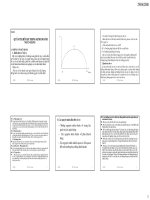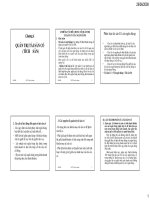slike bài giảng quản trị ngân hàng chương 6 lending to business and pricing business loans
Bạn đang xem bản rút gọn của tài liệu. Xem và tải ngay bản đầy đủ của tài liệu tại đây (1.1 MB, 47 trang )
LENDING TO BUSINESS FIRMS
AND PRICING BUSINESS
LOANS
Chapter 6
Key topics
1. Types of business loans: short- and long-term
2. Analyzing business loan requests
3. Collateral and contingent liabilities
4. Sources and uses of business funds
5. Pricing business loans
6. Customer profitability analysis (CPA)
17-2
Short term business loans
1. Self-liquidating inventory loans:
used to finance the purchase of inventory, taking
the advantage of cash cycle in a business firm
Demand for traditional inventory loans is on the
decline due to the development of the JIT (just
in time) and supply chain management
techniques
17-3
Self-liquidating inventory loans:
Cash cycle…
1. Cash is spent to acquire inventory
2. Goods are produced or shelved and listed for sale
3. Sales are made (often on credit)
4. The cash received is used to repay the self-
liquidating loan
17-4
Short term business loans
2. Working capital loans: closest to self-liquidating loans
Bank can set up a credit line (max funding need) in a certain
short period (a few months)
Loans can be renewed provided that the borrower pay off all
significant portion of the loan before the renewal
Loans are secured by account receivables, pledges of inventory
Borrower has to pay floating interest rate on disbursed amount
& a commitment fee is charged on unused credit line.
Compensating deposit balances may be required.
17-5
Short term business loans
3. Interim construction loans: support the construction of
homes, apartments, office buildings, etc.
Fund supplied to hire workers, lease construction equipments,
purchase building materials & develop land
The loan is paid off with a longer-term mortgage loan issued
by another lender
“Mini-permanent loan” providing fund for the construction
and early operation of a project in 5-7 years
17-6
Short term business loans
4. Security dealer financing:
short-term (overnight to few days) financing new securities
purchase backed by the dealers’ holdings of government
securities as collateral
Can be extended to investment banking firm in underwriting
new securities issued by the government or firms
Can be lent directly to businesses and individuals in buying
stocks, bonds, options, etc.
Margin requirements are enforced (≤ 50% of acquired
securities)
17-7
Short term business loans
5. Retailer and Equipment financing:
Banks finance receivables that dealers selling automobiles,
home appliances, furniture, business equipment,… take on
they write installment contracts to cover customer purchase
Contracts are purchased by lenders at an interest rate varying
with the borrower risk, collateral quality and loan terms
“Floor planning”: lender finances the dealer’s goods purchase
from manufacturer and be paid as goods are sold
17-8
Short term business loans
5. Asset-based financing:
Credit secured by the shorter-term assets of a firm that are
expected to roll over into cash in the future
Lender commits funds against a specific % of book value of
outstanding receivables or inventory
The borrower retains title to the asset pledged in most cases
Factoring: lender takes on responsibility of collecting
receivables. Due to higher risk → higher discount rate and
loan accounts for a smaller fraction of receivable book value
17-9
Short term business loans
5. Asset-based financing:
Credit secured by the shorter-term assets of a firm that are
expected to roll over into cash in the future
Lender commits funds against a specific % of book value of
outstanding receivables or inventory
The borrower retains title to the asset pledged in most cases
Factoring: lender takes on responsibility of collecting
receivables. Due to higher risk → higher discount rate and
loan accounts for a smaller fraction of receivable book value
17-10
Short term business loans
6. Syndicated loans (SNCs):
Loans package extended to a corporation by a lender group
Lender aims to reduce risk of large loans and earn fee income
(facility fee to open credit line or commitment fee to keep
credit available)
Many SNC loans are traded in the secondary (resale) market
carrying interest rate based on LIBOR on Eurodollar deposits
(1-4% above LIBOR)
17-11
Long-term business loans
1. Term loans
2. Revolving credit lines
3. Project loans
4. Loans to support acquisitions of other business firms
•
Question: What are the essential differences between
various short- and long-term business loans?
17-12
Term loans
Term loans are designed to fund long-term
business investment (equipment or construction)
1. A lump-sum loan is approved
2. Payment is made by amortization monthly/quarterly
3. Repayment source is from business earnings
4. Payment is scheduled based on firm’s cashflow cycle
5. Collateralization is made by fixed assets owned
either by the borrower or the guanrantee
6. Interest rate is either fixed or floated and higher than
short-term rate due to higher risk
7. “Bullet loan”: interest is paid periodically and no
principal is made till maturity date
17-13
Term loans:
attention should be paid to….
1. Qualification of the borrower’s management
2. Quality of accounting & auditing system
3. The borrower’s continuous filling in periodical financial
statements
4. The lender’s priority in claiming the borrower’s pledged
assets
5. Adequate insurance coverage
6. The borrower’s risk exposure to technology risk
7. Length of time before the project can generate positive cash
flow
8. Trend in market demand
9. Strength of borrower’s net worth posistion
17-14
Revolving credit lines
Allowing the customer to borrow up to pre-specified limit,
repay all or a portion of the borrowing and re-borrow as
necessary until the credit line matures
Being one of the most flexible business loan, granted
without specific collateral and maybe short-term or cover a
period as long as 5 years
Useful when firms are uncertain about timing of future cash
flow and borrowing need magnitude
Help even out fluctuations in business cycle
Loan commitment fee is charged on unused portion of
credit line or entire credit amount available
17-15
Project loans
The most risky of all business loans to finance fixed asset
construction designed to generate revenue in future (oil
refineries, power plants, harbor facilities…)
Risks are large and numerous, due to
Large funding is involved
Project maybe delayed caused by weather or material
shortage
Laws and regulations in the project location are negatively
changed
Interest rate change adversely affects the ability to pay
Loans are granted to several companies jointly sponsoring the
project and/or the project is co-financed by several lenders for
risk sharing
17-16
Project loans (cont.)
Project loan may be granted on
Recourse basis: lender can recover funds from the
sponsoring companies if the project fails to repay as
planned
Non-recourse basis: no sponsor guarantees, project
stands or falls on its own merit → higher loan rate and
more sponsor’s capital contribution due to higher risk
17-17
Loans to support firm acquisitions
Loans to finance mergers/acquisitions of businesses
Most noted: LBOs (leveraged buyouts)
Firm purchased is financed heavily by debt in the belief
that revenues can be raised higher than debt costs
Frequently optimistic assumptions have turned to be wrong
and loans have turned delinquent
17-18
Quick quiz
1. How business loans are classified in Vietnam?
2. What are the essential differences between various
short- and long-term business loans?
3. What special problems does business lending
present to the management of a business lending
institution?
Loan types (Decision 1627/2001/QD-NHNN)
1- Single loan (Cho vay từng lần): short- &long-term
2- Credit line loan (Cho vay theo hạn mức tín dụng): short-term
3- Project loan (Cho vay theo dự án đầu tư): long-term
4- Syndicated loan (Cho vay hợp vốn): short- &long-term
5- Installment loan (Cho vay trả góp): long-term for consumers
6- Stanby credit line loan (Cho vay hạn mức tín dụng dự
phòng): short-term
7- Credit card loan (Cho vay thông qua nghiệp vụ phát hành và
thanh toán thẻ tín dụng): short-term
8- Overdraft loan (Cho vay theo hạn mức thấu chi): short-term
Differences between short- & long-term
business loans
Long - term vs short-term loans:
large volume
long term
high default risk
Problems of business loans
Though business loans are usually considered among the
safest types (low default rate), these loans:
average much larger in dollar volume than other loans →
excessive risk of loss and, if a substantial number of loans
fail, can lead to failure
business loans are usually much more complex financial deals
than most other kinds of loans, requiring larger numbers of
personnel with special skills and knowledge. → increase the
magnitude of potential losses unless the business loan
portfolio is managed with great care & skill.
Analyzing business loan application
The lender’s margin for error is narrow, due to:
Large loan denomination
Yield spread reduction because of competition for best
customers
→ requiring special care by
Asking more repayment sources from borrowers
Analyzing the borrower’s financial statements
Pricing the loan correctly to cover costs & be competitive.
17-23
Sources of repayment for business loans
The borrower’s profits or cash flows
Business assets pledged as collateral
Strong balance sheet with ample marketable assets
and net worth
Guarantees given by businesses
17-24
Analyzing business loan applications
Common size ratios of customer over time
Financial ratio analysis of customer’s financial
statements
Current and pro forma sources and uses of funds
statement
17-25









